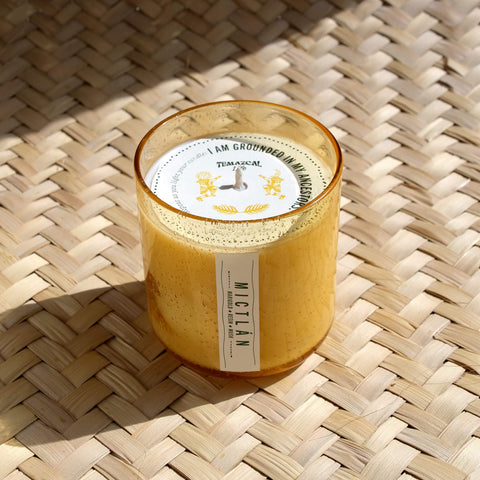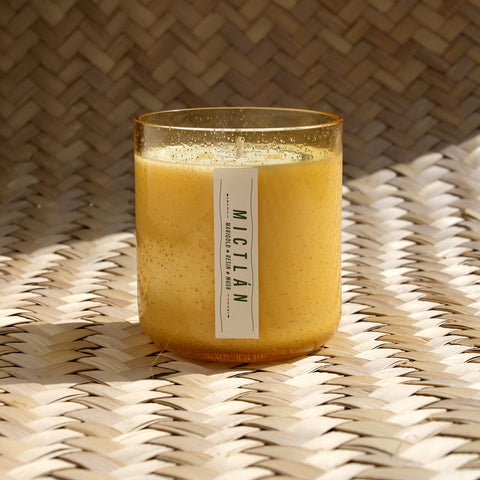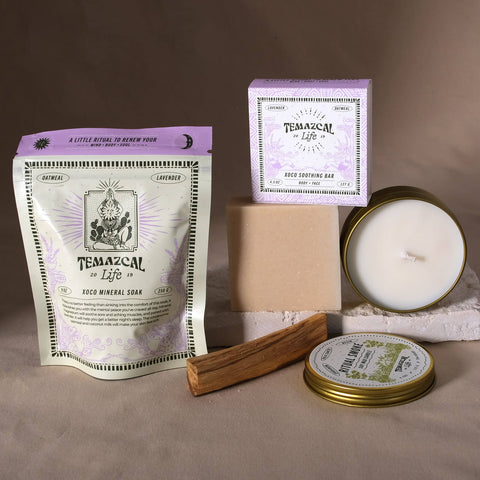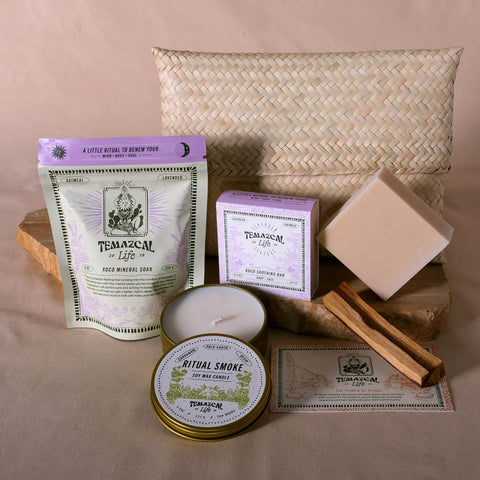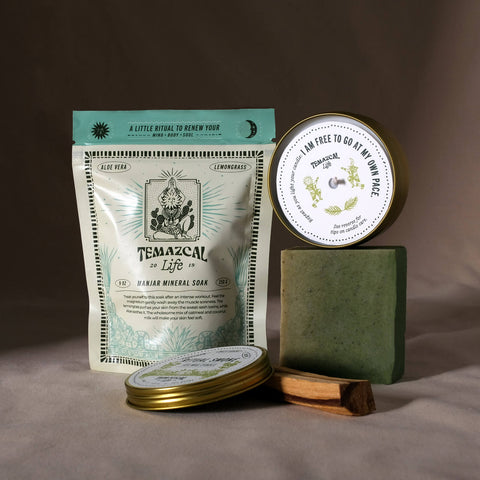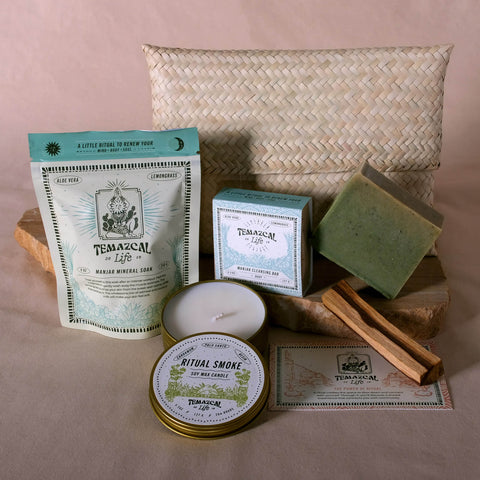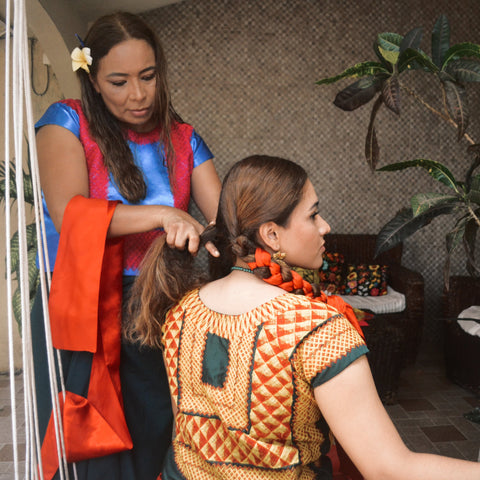
Communal care and ancestral rituals for modern healing.
At Temazcal, we strive to help you create and maintain a healthy connection between your mind and body by weaving ancestral rituals of communal care with modern personal care into our brand's fabric. Our offerings are carefully crafted to serve as tools for your most sacred personal care practices because we understand the challenges of caring for ourselves, our loved ones, and the healing power of ritual.
Overcoming Loneliness and Disconnection.
Recent studies 1,2,3,4 have reflected a rising percentage of people struggling with loneliness and an overall sense of disconnection. If that’s you, you’re not alone! Given that it’s been only a handful of years since the COVID-19 pandemic left the majority of our society feeling isolated and shut down, it’s no wonder that our collective battle with loneliness, anxiety, depression, and stress feels daunting, now more than ever. So much so, that U.S. Surgeon General Dr. Vivek H. Murthy published a study on the importance of social connection and community. The study found that loneliness has become a public health concern that we must address together, or “we will continue to splinter and divide.” The good news is that there is power in numbers, and you aren’t meant to face it alone. You never were!
The Healing Power of Rituals.
These issues are not exclusive to our time in history. It’s a battle our ancestors learned to grapple with long before many of us were born. A Harvard publication backed the phenomenon of Indigenous peoples holding strongly to their long-established rituals. “We need to take seriously the Indigenous claim I hear everywhere I go in Indian [sic] country, that ‘our culture is our treatment…’ [p]eople often say, ‘We don’t need the latest evidence-based practice or the latest greatest intervention that has come out of academia. We just need to go back to our traditions; we had our own healing ways. If we can just recapture and recover them, that will solve our problems.’”
Communities worldwide have begun to reflect a collective need to see through our struggles together by engaging in holistic practices. According to the same Harvard study from above, the Crystal Creek Lodge on the Blackfeet Nation in Montana ran a pilot treatment to address substance abuse that “featured activities for participants to engage in traditional skills such as tepee set up, berry picking, and cultural practices and ritual ceremonies.”
The program was positively received because, as Mental Health America reports, “[m]any Native/Indigenous tribes embrace a worldview that encompasses the notions of connectedness (with the past and with others), strong family bonds, adaptability, oneness with nature, the wisdom of elders, meaningful traditions, and strong spirit that may serve as protective factors when it comes to mental health.”
Foster Connection & Thrive Together
A community is so much more than an entity or a group of people. According to the National Alliance on Mental Illness, a community is “people you can call on when you need to talk or need help with something, [that] can help you through difficult situations that might feel insurmountable alone. Knowing there are people who support you can help you feel cared for and safe and benefit your outlook on life.”
As social beings, we aren’t meant to live in isolation. Not if we want to thrive, and most especially not if we struggle with mental health. Despite all that’s known about the power of connecting with our community, many of the younger generations are at a loss for how to change the tides.
According to Dr. Murthy, “[a]pproximately half of U.S. adults report experiencing loneliness, with some of the highest rates among young adults.” Studies have shown that 5,6 human connections are the most important to help us grapple with life's constant changes. It’s vital to foster this sense of community not just during the holidays, but in everyday life.
These findings affirm our mission at Temazcal Life to advocate for communal care and allow us to reflect on how we can honor our ancestors' struggles as they resisted colonial attempts to strip them of sacred community-building rituals for generations.
So, how do you find a sense of community? Who do you turn to when you need someone? How can you show up for them and, most importantly, yourself? By prioritizing these questions, you not only take part in defeating loneliness, but you honor your ancestors by fostering what they understood as the heart of any healthy society – your community.
Here is a short list of ideas for finding community:
- Invest time nurturing your relationships through consistent, frequent, and high-quality engagement with others.
- Participate in social and community groups such as fitness, religious, hobby, professional, and community service organizations to foster a sense of belonging, meaning, and purpose.
- Seek opportunities to serve and support others by helping your family, coworkers, friends, or strangers in your community or participating in community service.
- Actively engage with people of different backgrounds and experiences to expand your understanding of and relationships with others.
- Be responsive, supportive, and practice gratitude7,8 as these behaviors can strengthen our social bonds and improve our relationship satisfaction.
- Reduce practices that lead to feelings of disconnection from others, such as the harmful and excessive use of social media and spending time in unhealthy relationships.
- Seek help during times of struggle by reaching out to a family member, friend, counselor, health care provider, or the 988 Suicide and Crisis Lifeline.
- Be open with your healthcare provider about significant social changes in your life. This may help them understand potential health impacts and guide them to provide recommendations to mitigate health risks.
Join us as we delve deeper into mental wellness and communal care, one sacred ritual at a time—because building community starts with nurturing yourself. Together, let's honor our ancestors, celebrate traditions, and forge connections that withstand the test of time. Embrace well-being, embrace community, embrace Temazcal Life.
- Barreto, Manuela, et al. “Loneliness around the World: Age, Gender, and Cultural Differences in Loneliness.” Personality and Individual Differences, vol. 169, no. 0, Feb. 2021, https://doi.org/10.1016/j.paid.2020.110066.
- Cacioppo, John T., and Stephanie Cacioppo. “The Growing Problem of Loneliness.” The Lancet, vol. 391, no. 10119, Feb. 2018, p. 426, https://doi.org/10.1016/s0140-6736(18)30142-9.
- Cigna. “New Cigna Study Reveals Loneliness at Epidemic Levels in America.” The Big Picture, Mar. 2018, https://www.cignabigpicture.com/issues/june-2018/new-cigna-study-reveals-loneliness-at-epidemic-levels-in-america/. Accessed 2 Feb. 2024.
- Harvard School of Education, et al. Loneliness in America: How the Pandemic Has Deepened an Epidemic of Loneliness and What We Can Do About It. Feb. 2021, https://mcc.gse.harvard.edu/reports/loneliness-in-america.
- Thoits, Peggy A. “Mechanisms Linking Social Ties and Support to Physical and Mental Health.” Journal of Health and Social Behavior, vol. 52, no. 2, June 2011, pp. 145–61, https://doi.org/10.1177/0022146510395592.
- U.S. Department of Health and Human Services, Office of Disease Prevention and Health Promotion. “Social Cohesion - Healthy People 2030.” Healthy People 2030, 2020, https://health.gov/healthypeople/priority-areas/social-determinants-health/literature-summaries/social-cohesion#cit1. Accessed 2 Feb. 2024.
- Canevello, Amy, and Jennifer Crocker. “Creating Good Relationships: Responsiveness, Relationship Quality, and Interpersonal Goals.” Journal of Personality and Social Psychology, vol. 99, no. 1, July 2010, pp. 78–106, https://doi.org/10.1037/a0018186.
- Caputo, Andrea. “The Relationship Between Gratitude and Loneliness: The Potential Benefits of Gratitude for Promoting Social Bonds.” Europe’s Journal of Psychology, vol. 11, no. 2, May 2015, pp. 323–34, https://doi.org/10.5964/ejop.v11i2.826.
